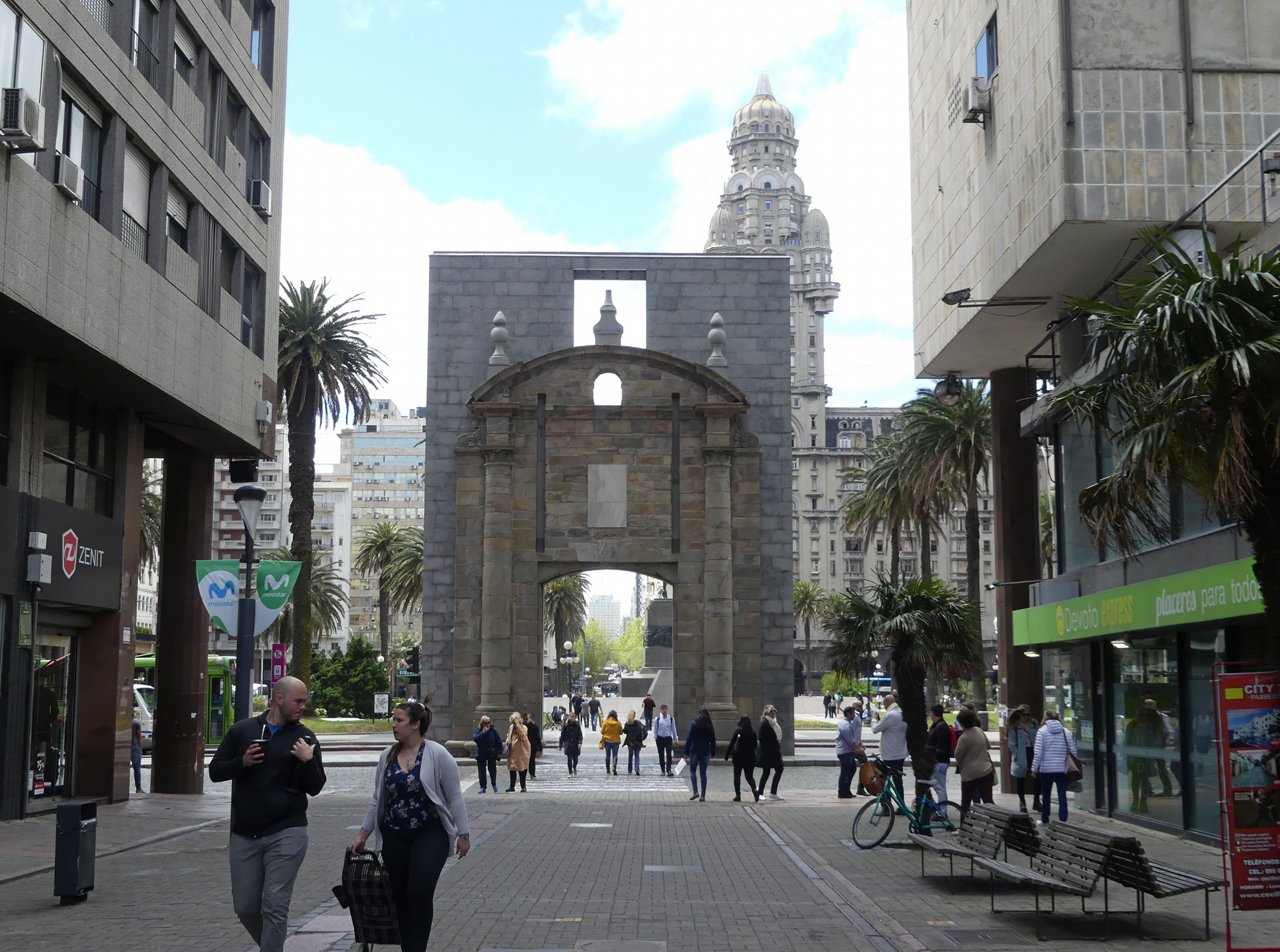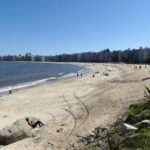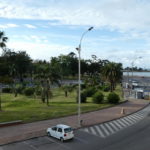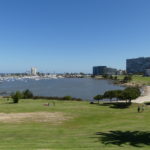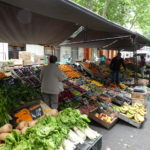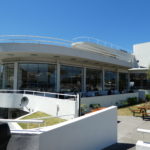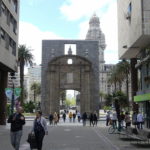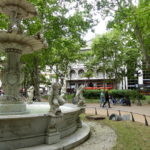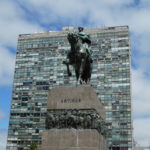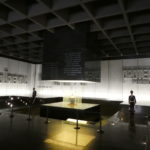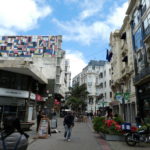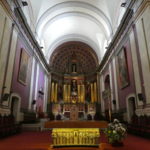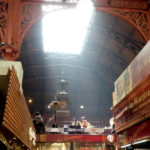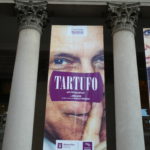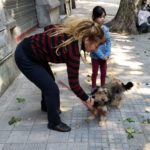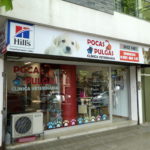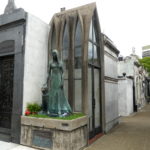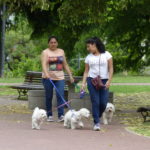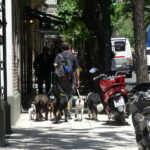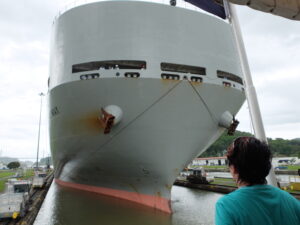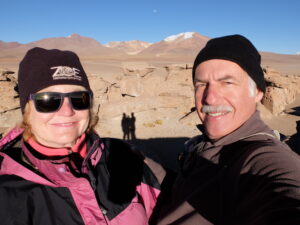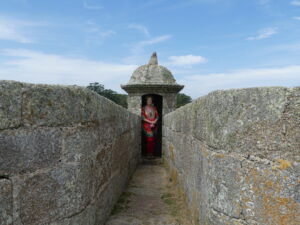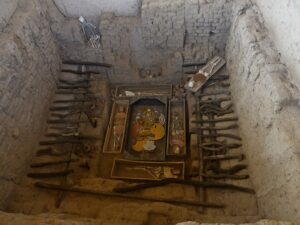Our home for the next six months is Montevideo, capital of Uruguay. The country is about the size of Missouri, but with a population of only 3.5 million. Just 1.5 million live in the city itself, which is much more relaxed, congenial and laid-back than the huge cities of neighboring Argentina and Brazil. And Montevideo has so much to offer including extensive beachfront, parks and open air markets, as we explain with these pictures.
Montevideans delight in about 25 kilometers (15 miles) of public beachfront, along which a ‘rambla’ lets you cruise – by foot, skates, bike or even windsurf – along its whole length. For much of that beachfront, medium-rise apartment buildings line the roadway, each with a beach view; farther out from the central city, a surprising number of individual houses remain. With tides going in and out, the coast feels like an ocean, but we’re actually on the widest river in the world, the Rio de la Plata. Upriver by ferry is Rio de Janeiro.
Our apartment view. The large park across the way is called Parque Rodo, named for a famous Uruguayan poet. Less than a block from us is the rambla and beachfront, full of people on nice evenings and weekends. On Sunday, artisans and vendors of all sorts of goods take over a big piece of the park. In the afternoon and evening, we often hear the beat of Uruguay’s favorite music, Candombe, as a host of drummers bring their barrel-shaped wood drums into the park to pound on.
Alongside the beaches, as well as inland throughout the city, there is plenty of greenspace and parkland like this, readily enjoyed in Uruguay’s temperate climate. Traffic is light even in rush hour, partly because an extensive network of noisy diesel buses (under $1 USD per trip) takes you wherever you want to go.
Unlike people in many South American cities, Montevideans tend to shop for daily items in small tiendas or, when available, shopping malls – instead of central produce markets. However, every day in every neighborhood, it seems, a pop-up feria – or open air market – takes over a local street and attracts plenty of shoppers to the fresh produce.
At several major intersections along the beachfront, bars and restaurants offer places to relax for people enjoying the ramblas. This huge McDonald’s may not be the best of the bunch, but it has the best buidling, an art deco structure that must have seen some other usage awhile ago.
Enjoying a nice dinner at a top vegetarian spot nearby (not the McDonald’s), with our new local friends in Montevideo.
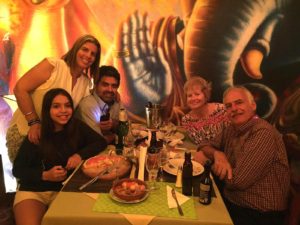
FREE WALKING TOUR
NOTE: We love the increasingly popular “free” walking tours offered within cities we visit, as we learn so much about the history, culture and attractions of a city right away. The “free” is in quotes because tipping of the guide is how they can afford to deliver the service.
Our “free walking tour” of Montevideo was less about attractions – though the plazas, parks and veteran buildings you see in these photos were worth seeing – as it was about Uruguay and its culture. This has long been a social democracy somewhat different from neighboring ones. Religion and government are completely separated, a split enshrined in Uruguay’s constitution. Healthcare and education through university are free to all. Marijuana is legal to grow and smoke, but not for foreigners to purchase. The leaders of the country, including the President, are typically seen without any security guards, walking about the streets or chatting up locals at cafes. It’s an easy going place.
A view to the central plaza of the newer central city, Plaza de Independencia. The gate is the last vestige of the old defensive city walls which crossed this site. In the background is the eclectic tower of a short-lived luxury hotel, designed as were so many other structures here by Italian architects and a clone of one in Buenos Aires.
The charming central plaza of the old city, Plaza Constitucion, a classic colonial plaza, shaded with trees and open to the street – with the cathedral on one side, the city government on another, and a central fountain for good measure. On the fountain pedestal is carved a Masonic emblem, for Masons have long been strong in the leadership of the country, as in the United States. A few blocks away is Plaza Zambala, designed to imitate a Parisian park complete with an iron fence – and oddly skewed 45 degrees from the street grid.
Jose Gervasio Artigas, honored as the founding father of Uruguay because he fought for independence from Spain as well as Portugal and protected the rights of the peasant population – though he lived much of his 86 years elsewhere. The US and French revolutions inspired him. The statue boldly dominates the Plaza de Independencia, though he is somewhat dishonored by that ugly high-rise behind him. His ashes are below.
The underground memorial to Artigas, where two honorary soldiers always stand near the urn containing his ashes. The muted lighting together with the boldly carved memories of his life and words are pretty impressive.
A pedestrian street leading to the old city from Plaza de Independencia, lined by a mix of gracious older buildings and unimaginative newer ones. That mural on the upper left is by one of the most famous painters from Uruguay, Joaquín Torres-García. On the ground you can follow the Walk of Fame, where plaques adorned with the multi-rayed sun of the Uruguayan flag honor an odd array of personages. There weren’t enough famous Uruguayans to honor, so one plaque celebrates the Rolling Stones because they came to Montevideo twice, not just once, while another remembers an accountant for some reason.
Glowing apse of Montevideo’s cathedral on Plaza Constitucion, with a stunning modern altarpiece.
The 19th century Mercado del Puerto, the iron and wood structure near the port that housed Montevideo’s central market for foods and goods. Now it consists of restaurants and vendors of local products, mostly for the delight of tourists off the cruise ships docked nearby.
TARTUFO & TEATRO SOLIS
Why not? ¿Por que no? Pourquoi pas? A French play by Moliere, a Spanish translation in Uruguayan accent (not ‘yo’ for the word ‘I’, but ‘djo’, for example).
We might not have understood all of the rapid fire dialogue, but this excellent Comedia Nacional performance of “Tartuffe” made for a pleasurable evening at Montevideo’s Teatro Solis.
Teatro Solis is the main performing hall of Montevideo. It was designed for the rich and famous to gather, but has now been renovated for broader artistic purposes, open to the public for theatre, dance and music performances in several different halls.
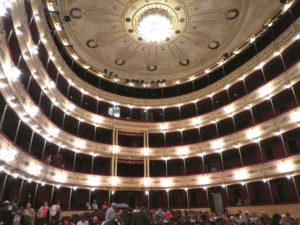
DOGS!
We are delighted that pets are beloved in the region. Walkers often exercise a host of dogs on the streets and in the parks.
There is a vet/pet store on every other corner, and pets are welcome in many cafes and restaurants.
Nearby in Buenos Aires, we saw another example of this devotion.
A memorial at one of the most famous of cemeteries, La Recoleta, features a brass dog (with a much rubbed, shiny nose) who accompanies his friend forever.
(Also, for more pictures from Uruguay, CLICK HERE to view the slideshow at the end of the itinerary page.)


